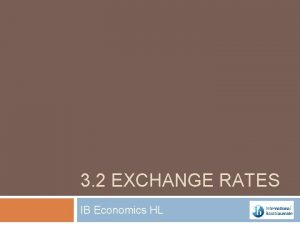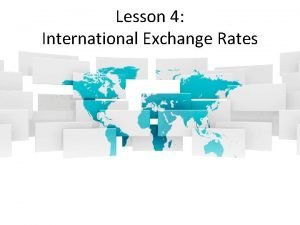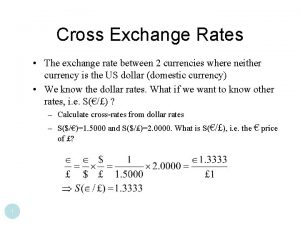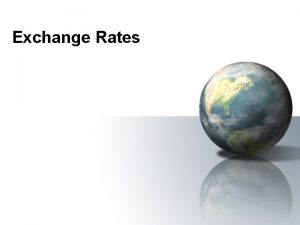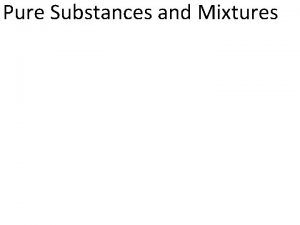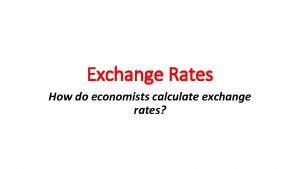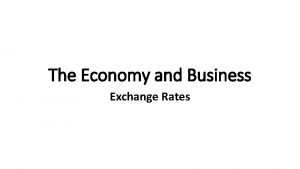Exchange Rates There are two pure types of










- Slides: 10


Exchange Rates • There are two “pure” types of exchange-rate systems: – Flexible Exchange Rates - a flexible, or floatingexchange-rate system, through which demand supply determine exchange rates and in which no government intervention occurs. – A Fixed-exchange-rate system through which governments determine exchange rates and make necessary adjustments in their economies to maintain those rates.

Determinants of Exchange Rates • What factors would cause a nation’s currency to appreciate or depreciate in the market foreign exchange? • Here are three generalization: – If the demand for a nation’s currency increases, that currency will appreciate; if the demand declines, that currency will depreciate. – If the supply of a nation’s currency increases, that currency will depreciate; if the supply decreases, that currency will appreciate. – If a nation’s currency appreciates, some foreign currency depreciates relative to it

• With these generalizations in mind, the determinants of exchange rates – the factors that shift the demand or supply curve for a certain currency. • Changes in Tastes – Any change in consumer tastes or preferences for the products of a foreign country may alter the demand for that nation’s currency and change its exchange rate. • If technological advances in the U. S. wireless phones make them more attractive to British consumers and businesses, then the British will supply more pounds in the exchange market in order to purchase more U. S. wireless phones.

• The supply of pounds curve will shift to the right, causing the pound to depreciate and the dollar to appreciate. • In contrast, the U. S. demand-for-pounds curve will shift to the right if British woolen apparel becomes more fashionable in the U. S. So the pound will appreciate and the dollar will depreciate.

Relative Income Changes • A nation’s currency is likely to depreciate if its growth of national income is more rapid t than that of other countries. • Here is why: A country’s imports vary directly with its income level • As total income rises in the U. S. , people there buy both more domestic goods and more foreign goods. • If the U. S. economy is expanding rapidly and the British economy is stagnant, U. S. imports of British goods, and therefore U. S. demand for pounds, will increase. • The dollar price of pounds will rise, so the dollar will depreciate.

Relative Price-Level Changes • Changes in the relative price levels of two nations may change the demand supply of currencies and alter the exchange rate between the two nations’ currencies. • The purchasing-power-parity theory holds that exchange rates equate the purchasing power of various currencies. • That is, the exchange rates among national currencies adjust to match the ratios of the nations’ price levels: • If a certain market basket of goods costs $10, 000 in the U. S. and 5, 000 pounds in Great Britain, according to this theory the exchange rate will be $2 = 1 pound. • That way, a dollar spent on goods sold in Britain, Japan, Turkey, and other nations will have equal purchasing power.

• In practice, however, exchange rates depart from purchasing power parity, even over long periods. • Nevertheless, changes in relative price levels are a determinant of exchange rates. • If, for example, the domestic price level rises rapidly in the U. S. and remain constant in great Britain, U. S. consumers will seek out low-priced British goods, increasing the demand for pounds. • The British will purchase fewer U. S. goods, reducing the supply of pounds. • This combination of demand supply changes will cause the pound to appreciate and the dollar to depreciate.

Relative Interest rates • Changes in relative interest rates between two countries may alter their exchange rate. • Suppose that real interest rates rise in the U. S. but stay constant in Great Britain. • British citizens will then find the U. S. an attractive place in which to make financial investments. • To undertake these investment, they will have to supply pounds in the foreign exchange market to obtain dollars. • The increase in the supply of pounds results in depreciation of the pound appreciation of the dollar.

Speculation • Currency speculators are people who buy and sell currencies with an eye toward reselling or repurchasing them at a profit. • Suppose speculators expect the U. S. economy to – 1. grow more rapidly than the British economy and – 2. experience a more rapid rise in its price level than will Britain. • These expectations translate into an anticipation that the pound will appreciate and the dollar will depreciate. • Speculators who are holding dollars will therefore try to convert them into pounds. • This effort will increase the demand for pounds and cause the dollar price of pounds to rise. • A self-fulfilling prophecy occurs: The pound appreciates and the dollar depreciates because speculators act on the belief that these changes will in fact take place. • In this way, speculation cause changes in exchange rates








